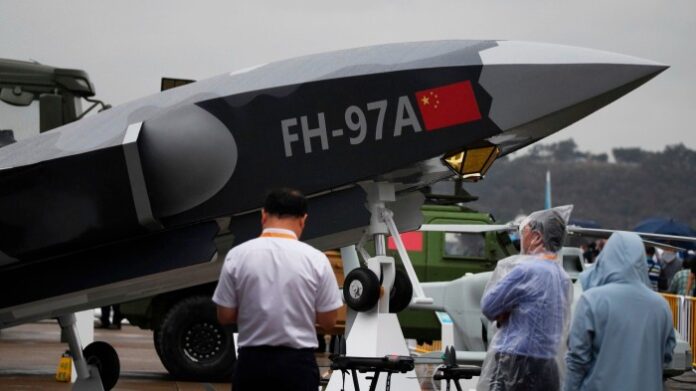Unlock the Editor’s Digest for free
Roula Khalaf, Editor of the FT, selects her favourite stories in this weekly newsletter.
China’s development of stealth fighter jets has drawn global attention, but just as significant, analysts say, is the unveiling of its attack drones — a fast-emerging area of defence competition with the US.
The updated Feihong FH-97A, a so-called loyal wingman drone, of which a prototype was on static display last month at the biennial Zhuhai air show in southern China, boasts an enhanced weapons bay, allowing it to conduct both ground and air strikes. The drone, designed to accompany crewed aircraft, also has the ability to catapult launch from aircraft carriers.
The mass adoption of drones on both sides of Russia’s war against Ukraine has shaken up the global defence industry in recent years, with militaries around the world seeking to integrate the latest unmanned technologies into their arsenals.
Analysts say wingman drones are now at the centre of the technological race between China and the US for air superiority, a competition that has only become more pressing as tensions escalate over Taiwan, which Beijing views as its territory and has threatened to claim by force if necessary.
“In the future, [the FH-97A] will be extremely important,” said Ni Lexiong, a Shanghai-based military analyst. “The future of war will be competition between drone and anti-drone technology.”
Wingman drones offer Chinese manufacturers a space to catch up with the US military, said Peter Layton, associate fellow at the Royal United Services Institute think-tank.
He said China had built and was flying some wingman drones that it aimed to “operate with the two-seat version of the J-20”, China’s older stealth fighter. But showing models at air shows was “different from actually flying them” operationally, Layton said, adding that details were too scarce to determine which country was ahead.
The FH-97A, developed by Aerospace Times Feihong Technology Corp, is designed for “confrontational, high-intensity and long-lasting combat”, its parent company, the state-owned Ninth Academy of China Aerospace Science and Technology Corp, wrote in a WeChat post last month.
The aircraft will be able to both lead swarms of smaller drones and act as a companion “wingman” to manned stealth fighter jets, with the fighter pilots controlling their own plane and the accompanying drone, according to analysts.
“The FH-97A drone meets the four [main] trends in the development of weapons . . . it is unmanned, miniaturised, intelligent and stealthy,” said Ni.
Militaries around the world are looking to wingman technology, which would allow them to dramatically strengthen their aerial forces at a lower cost than producing manned fighter jets and training pilots.
The US is also pushing ahead with its own loyal wingmen programme, known as collaborative combat aircraft (CCA), following delays to work on parts of its sixth-generation fighter, analysts said.
“Loyal wingpersons are . . . one of the things that every air force, every major company, wants,” said Sash Tusa, an aerospace and defence analyst at Agency Partners. “It’s a way of restoring scale as manned aircraft get more expensive, it’s a way of increasing coverage geographically [and] it’s a way of increasing weapon loadout.”
He estimated that it would take leading militaries five to 10 years to be able to deploy the technology, with cost effective production a major hurdle. “If anyone does it, it will probably be the Americans or the Chinese first.”
Other experts said that, based on the available information about each country’s prototypes, China’s loyal wingperson drones may have an advantage, given their claimed ability to carry out ground strikes.
Layton said the US and its allies — such as Australia, which is developing the Ghost Bat loyal wingman drone with Boeing — appeared to be concentrating on drones that carried sensors rather than weapons, which require increasing the size and weight of the aircraft.
With the US planning to deploy 150 loyal wingmen by the end of the decade, he predicted that the aircraft would “rely a lot on artificial intelligence”.
The US is “moving fairly fast”, Layton added.
James Char, assistant professor and an expert on China’s military at Singapore’s Nanyang Technological University, said the US and China were also developing various land and sea drones, such as China’s robot wolves.
These assault-rifle armed machines can operate in packs and were designed to clear beaches of defensive forces, according to state media — a capability with possible implications for any conflict over Taiwan.
“We are seeing a lot of reports about what these drones can do on the battlefield,” he said. “But what they can actually do, no one is sure.”

